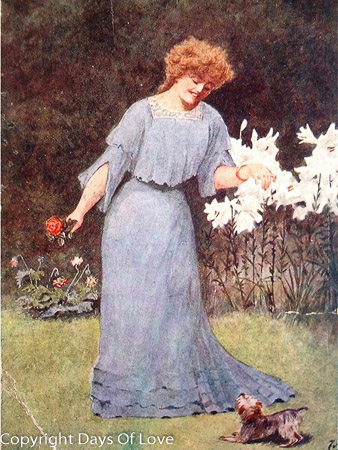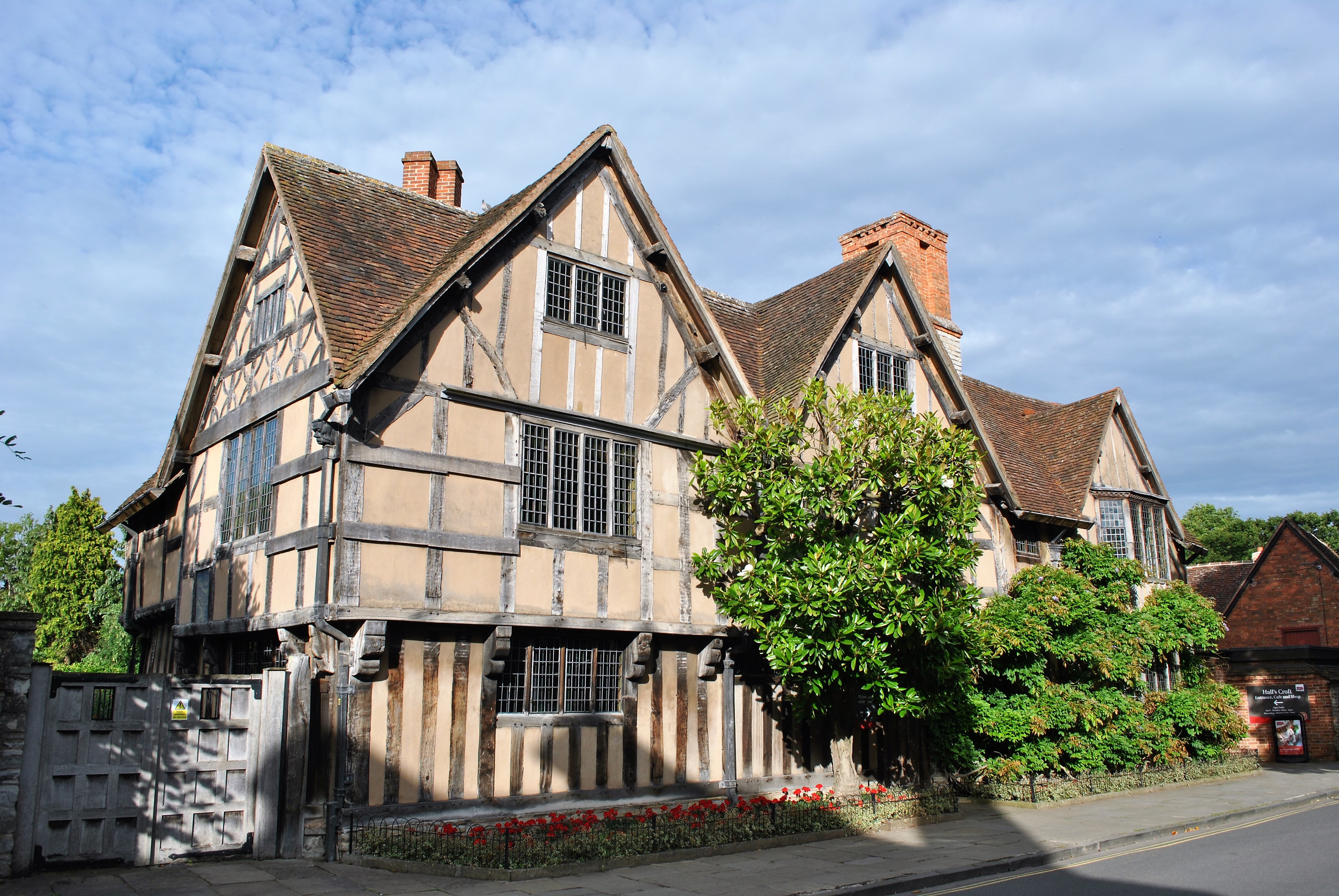BURIED TOGETHER
Partner Bertha Vyver, buried together
Queer Places:
24 Gloucester Cres, London NW1 7DL, Regno Unito
40 Camden Square, London NW1 9XA, Regno Unito
47 Longridge Rd, Earls Court, London SW5, Regno Unito
Mickleham, Dorking RH5 6DL, Regno Unito
Hall's Croft, Old Town, Stratford-upon-Avon CV37 6BG, Regno Unito
Mason Croft, Church St, Stratford-upon-Avon CV37 6HP, Regno Unito
Evesham Road cemetery, 32 Evesham Rd, Stratford-upon-Avon CV37 9AA, Regno Unito
 Marie
Corelli (1 May 1855 – 21 April 1924) was an English novelist and
mystic. In the relationship with Bertha Vyver, Bertha was "Mamasita" and
Marie "Little Girl". Vyver edited Corell's memoirs "Memoirs of Marie
Corelli". Marie Corelli was supported
both emotionally and professionally throughout her career by Bertha Vyver.
Bertha was the daughter of a French Countess and gave up her own career as
a painter to help promote Marie's career, encouraging Marie to regard
herself as a talented novelist and creating the successful persona of
Marie Corelli. Adopting a mortherly role towards Maries, who described
herself to Bertha as "your wee little one", Bertha kept house and nursed
Marie's invalid father, while Marie financially supported them both.
Bertha's role was not, however, a purely private one and the two women
also attended public functions together as a couple.
Marie
Corelli (1 May 1855 – 21 April 1924) was an English novelist and
mystic. In the relationship with Bertha Vyver, Bertha was "Mamasita" and
Marie "Little Girl". Vyver edited Corell's memoirs "Memoirs of Marie
Corelli". Marie Corelli was supported
both emotionally and professionally throughout her career by Bertha Vyver.
Bertha was the daughter of a French Countess and gave up her own career as
a painter to help promote Marie's career, encouraging Marie to regard
herself as a talented novelist and creating the successful persona of
Marie Corelli. Adopting a mortherly role towards Maries, who described
herself to Bertha as "your wee little one", Bertha kept house and nursed
Marie's invalid father, while Marie financially supported them both.
Bertha's role was not, however, a purely private one and the two women
also attended public functions together as a couple.
Marie Corelli enjoyed a period of great literary success from the publication of
her first novel in 1886 until
World War I. Corelli's novels sold more copies than the combined sales
of popular contemporaries, including
Arthur Conan Doyle,
H.G. Wells, and
Rudyard Kipling, although critics often derided her work as "the
favourite of the common multitude".
Mary Mackay was born in London to Elizabeth Mills, a servant of the Scottish
poet and songwriter Dr
Charles Mackay, her biological father.[2]
In 1866, eleven-year-old Mary was sent to a Parisian
convent to
further her education. She returned to Britain four years later in 1870.
Mackay began her career as a musician, adopting the name Marie Corelli
for her billing. Eventually she turned to writing and published her first
novel,
A Romance of Two Worlds, in 1886. In her time, she was the most
widely read author of fiction. Her works were collected by
Winston Churchill,
Randolph Churchill, and members of the
British Royal Family, among others.[3]
She faced criticism from the literary elite for her overly melodramatic
writing. In
The Spectator,
Grant Allen called her "a woman of deplorable talent who imagined that
she was a genius, and was accepted as a genius by a public to whose
commonplace sentimentalities and prejudices she gave a glamorous setting."
[4]
James
Agate represented her as combining "the imagination of a
Poe with the style of an
Ouida and
the mentality of a nursemaid."[5][6]
A recurring theme in Corelli's books is her attempt to reconcile
Christianity with
reincarnation,
astral projection, and other mystical ideas. She was associated at
some point with the
Fraternitas Rosae Crucis; a
Rosicrucian and mystical organization.,[7][8][9]
and her books were a part of the foundation of today's corpus of
esoteric philosophy. Her portrait was painted by
Helen Donald-Smith.
Corelli famously had little time for the press. In 1902 she wrote to
the editor of
The Gentlewoman to complain that her name had been left out of a
list of the guests in the Royal Enclosure at the
Braemar
Highland Gathering, saying she suspected this had been done
intentionally. The editor replied that her name had indeed been left out
intentionally, because of her own stated contempt for the press and for
the snobbery of those wishing to appear in "news puffs" of society events.
Both letters were published in full in the next issue.[10]
Corelli spent her final years in
Stratford-upon-Avon. There she fought hard for the preservation of
Stratford's 17th-century buildings, and donated money to help their owners
remove the plaster or brickwork that often covered their original
timber-framed façades.[11]
Novelist
Barbara Comyns Carr mentions Corelli's guest appearance at an
exhibition of Anglo-Saxon items found at
Bidford-on-Avon in 1923.[12]
Corelli's eccentricity became well known. She would boat on the
Avon in a
gondola,
complete with a
gondolier, whom she had brought over from
Venice.[13]
In
his autobiography,
Mark
Twain, who had a deep dislike of Corelli, describes visiting her in
Stratford and how the meeting changed his perception.

Hall's Croft

Mason Croft
For over forty years, Corelli lived with her companion,
Bertha Vyver,[14]
to whom she left everything when she died. She did not identify herself as
a lesbian,
but several biographers and critics have noted the frequent erotic
descriptions of
female beauty that appear in her novels, although they are expressed
by men.[15][16][17]
Corelli was known to have expressed a genuine passion for the artist
Arthur Severn, to whom she wrote daily letters from 1906 to 1917. Severn
was the son of
Joseph Severn and close friend to
John Ruskin. In 1910, she and Severn collaborated on The Devil's
Motor, with Severn providing illustrations for Corelli's story. Her
love for the long-married painter, her only known romantic attachment to a
man, remained unrequited; in fact Severn often belittled Corelli's
success.[18][19][20]
During the
First World War, Corelli's personal reputation suffered from being
convicted of
food hoarding.[21]
She died in Stratford and is buried there in the Evesham Road cemetery.[22]
Later
Bertha Vyver was buried alongside her.

Corelli is generally accepted to have been the inspiration for at least
two of E. F. Benson's characters in his Lucia series of six novels and a
short story. The main character, Emmeline "Lucia" Lucas, is a vain and
snobbish woman of the upper middle class with an obsessive desire to be
the leading light of her community, to associate with the nobility, and to
see her name reported in the social columns, coupled with a comical
pretension to education and musical talent, neither of which she
possesses. She also pretends to be able to speak Italian, something
Corelli was known to have done. Miss Susan Leg is a highly successful
writer of pulp romances under the pseudonym Rudolph da Vinci. The
character makes her appearance in Benson's work a few years after Marie
Corelli's death in 1924.
A modern critic has written that Corelli was probably also the
inspiration for "Rita's" (Eliza
Humphreys's) main character in Diana of the Ephesians, which
was published a year before E. F. Benson's first Lucia novel, and had been
rejected by Hutchinson, which later published the "Lucia" Lucas novels.[23]
In 2007, the British film
Angel, based on a book by
Elizabeth Taylor, was released as a thinly-veiled biography of
Corelli. The film starred
Romola Garai in the Corelli role and also starred
Sam
Neill and
Charlotte Rampling. It was directed by
François Ozon, who stated, "The character of Angel was inspired by
Marie Corelli, a contemporary of
Oscar Wilde and
Queen Victoria's favourite writer. Corelli was one of the first
writers to become a star, writing bestsellers for an adoring public. Today
she has been totally forgotten, even in England."[[2[[24]
My published books:


BACK TO HOME PAGE
- https://en.wikipedia.org/wiki/Marie_Corelli
- A Lesbian History of Britain: Love and Sex
Between Women Since 1500, Rebecca Jennings, Greenwood World Pub., 2007
 Marie
Corelli (1 May 1855 – 21 April 1924) was an English novelist and
mystic. In the relationship with Bertha Vyver, Bertha was "Mamasita" and
Marie "Little Girl". Vyver edited Corell's memoirs "Memoirs of Marie
Corelli". Marie Corelli was supported
both emotionally and professionally throughout her career by Bertha Vyver.
Bertha was the daughter of a French Countess and gave up her own career as
a painter to help promote Marie's career, encouraging Marie to regard
herself as a talented novelist and creating the successful persona of
Marie Corelli. Adopting a mortherly role towards Maries, who described
herself to Bertha as "your wee little one", Bertha kept house and nursed
Marie's invalid father, while Marie financially supported them both.
Bertha's role was not, however, a purely private one and the two women
also attended public functions together as a couple.
Marie
Corelli (1 May 1855 – 21 April 1924) was an English novelist and
mystic. In the relationship with Bertha Vyver, Bertha was "Mamasita" and
Marie "Little Girl". Vyver edited Corell's memoirs "Memoirs of Marie
Corelli". Marie Corelli was supported
both emotionally and professionally throughout her career by Bertha Vyver.
Bertha was the daughter of a French Countess and gave up her own career as
a painter to help promote Marie's career, encouraging Marie to regard
herself as a talented novelist and creating the successful persona of
Marie Corelli. Adopting a mortherly role towards Maries, who described
herself to Bertha as "your wee little one", Bertha kept house and nursed
Marie's invalid father, while Marie financially supported them both.
Bertha's role was not, however, a purely private one and the two women
also attended public functions together as a couple.


